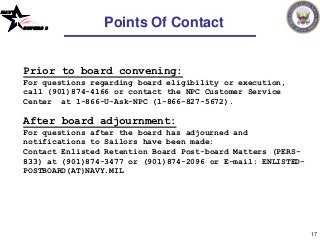The Enlisted Retention Board (ERB) is a panel that reviews Sailors’ records to determine their continued eligibility to serve in the Navy. These records reflect the Sailor’s performance and fitness for service. In addition to this, the ERB will review the Sailor’s eligibility for Transition services.
Phase II of the Enlisted Retention Board (ERB) to review eligible Sailors
In its first phase, the Navy’s Enlisted Retention Board (ERB) reviewed the records of over 7,700 Sailors to determine which are most likely to be retained. This phase will continue until the end of September, with Phase II (for E6-E8) set to convene sometime later this month.
The Enlisted Retention Board (ERB) was created to reduce over manning in the Navy’s 31 ratings and help meet the end-strength goals mandated by Congress. The ERB process was designed to be completed in two phases, each lasting about four weeks. Phase one evaluated the records of approximately 16,000 Sailors who are E-4 and E-5 pay grades, while Phase two focuses on Sailors with more than 15 years of service.
The ERB is comprised of an officer and master chief, as well as a flag officer. Commanding officers will receive the results of the review in BUPERS Online and will have seven days to counsel Sailors not selected for retention. After the review is complete, those Sailors who were not chosen for retention must transfer to the fleet reserve or retire by Sept. 30, 2012.
OMPF records reflect a member’s fitness for service, performance, and entitlements
OMPF records contain a member’s history and details of his or her fitness for service, performance, and entitlements. These documents are kept by the Navy Personnel Command. They are electronically submitted when a member leaves the service, re-enlists, or retires. OMPF also maintains the Permanent Personnel Record (PERS-313). It is important to review both documents together and make sure the information contained in both documents is accurate. If there are discrepancies, personnel support representatives will be able to make any necessary corrections.
OMPF records are maintained in the Electronic Military Personnel Record System (EMPRS). OMPFs contain documents relating to a member’s fitness for service, health, and performance. These records are important to a member’s career and are used for selection and review boards. The files also include a member’s personal documents.
OMPF records also contain administrative actions and personal information. OMPFs contain start dates, which are dates when the Military Services began scanning the records. If a member’s discharge date is close to the start date, the records may not be available online. Veterans should contact the National Personnel Records Center to view their records.
OMPF records reflect a Sailor’s fitness for service, performance, and entitlements
An OMPF record is a permanent document containing information about a Sailor’s performance, fitness for service, and entitlements. It is used by selection boards to evaluate potential candidates for different roles and to maintain information on an individual’s career. These documents may also contain information about a Sailor’s qualifications and training.
OMPF records are maintained by the Department of Defense to ensure that Sailors are fit for service and perform well in their respective jobs. This means that the newest NAVPERS 1070/602 records must be accurate. Additionally, all Sailors must verify data on their dependency data panels and emergency contacts.
The CPO Selection Board can view information from field codes 30 – 38 of the OMPF, as well as the Soldier’s Letter to the Selection Board. However, they cannot access NSIPS or PRIMS.
Transition services for affected Sailors
The Erb Navy separation has left Sailors with questions about their future. The Navy contracted a firm to provide comprehensive transition services for affected Sailors. One of those services is resume assistance. The firm has helped more than 1,300 Sailors find a new career.
Navy leadership must actively be involved in the transition process. It must provide guidance, time, and opportunities for the affected Sailors to make the transition as smooth and stress-free as possible. The Navy leadership at JB MDL is committed to providing seamless transition services to all affected Sailors.
The Navy Personnel Command has enhanced outreach to affected Sailors through the Shipmates to Workmates initiative and other means. Navy personnel officers and civilian staff members have visited ERB concentration areas and met with ERB Sailors and their families. The goal is to help ERB Sailors transition into civilian life and to maximize their potential for success.
